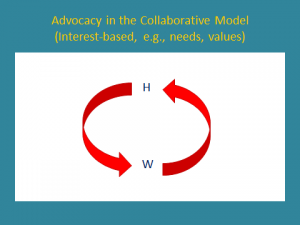 As a confirmed New Yorker subscriber, I enjoy the cartoons as much as the writing. Indeed, the cartoons alone would justify my subscription. Earlier this year, there was a drawing of a customer addressing a florist.
“I want some flowers that say, ‘Here! Have some frickin’ flowers!'”
For a lot of couples about to enter into a dissolution of their marriage, the holidays are a time of high anxiety. Often, both spouses know it’s coming–soon–but call a truce in order not to wreck the children’s Christmas.
According to some of my former clients who have done that, the whole holiday season felt like, “Here! Have a frickin’ truce!”
Tense, hollow, sarcastic. Anxiety-ridden, courtesy of the Unknown.
A close friend who knows about my practice once asked me, “What’s the most important thing you can tell someone who comes in to see you about a divorce?”
“Well, it will depend on what’s most important to that person at that moment, but, generally speaking, I’d want them to know it’s going to be all right,” I said.
“Isn’t that a little misleading? I mean, you don’t know anything about who they’re married to, or who that person’s lawyer is, or anything.”
“Well, I know this: when they talk to me, they’re living in a situation that’s become unbearable, a situation they know very well. And it’s bad enough that they’re talking to me about an Unknown–the divorce–that they’d rather deal with. I actually did once ask a client who was complaining about how long it was taking and how much it was costing whether he’d like to dismiss the action and stay married. He looked at me like I had two heads. ‘Not on the longest day you live,’ he said.”
So the goal was not an issue. By the way, that was before I began doing Collaborative cases. But my point is that the divorce itself will end some day, and probably in less than a year. And after it’s over, that person will go on with their life.
Most of the time, the people who come to me know that I do mostly Collaborative cases, where the couples have to agree on what happens before anything can happen, and where the goal is to agree on all the terms of the divorce. So they each have to give their spouse a reason to agree to what they’re seeking. More importantly, they have many opportunities over the weeks of that case to refine the conversation, discover what’s at the heart of their goals, and explore different ways of satisfying their spouse’s interests.
The upshot is that by the time they do reach all their agreements, they have talked everything through–usually multiple times–and they have a set of agreements they can live with. And things going forward are going to be all right! They can take some reassurance in that because their discussions were all based on their actual situation, not what they wish their situation was. They’ve spoken with their lawyers and they understand what the courts can do and what they won’t do.
In the Decree, under “real estate,” the court simply can’t award to the spouse who had an affair “the hottest corner of Hell.” For one thing, there’s no legal description. But if their husband or wife insists that this is the only appropriate residence for them, post-decree, I know that person will never succeed in a Collaborative case. I also know that person won’t “succeed” in court, either. And, finally, I know that person could care less if things turn out “all right,” because their highest priority is to give back the pain they feel to the person who, they believe, caused it. They almost certainly will get more help from a therapist than a lawyer.
But for the potential client who is most interested in ending their marriage, attending to their affairs, and starting a new life, history teaches us, time and again, that, really, it will be all right.
At least, that’s what my clients tell me.
As a confirmed New Yorker subscriber, I enjoy the cartoons as much as the writing. Indeed, the cartoons alone would justify my subscription. Earlier this year, there was a drawing of a customer addressing a florist.
“I want some flowers that say, ‘Here! Have some frickin’ flowers!'”
For a lot of couples about to enter into a dissolution of their marriage, the holidays are a time of high anxiety. Often, both spouses know it’s coming–soon–but call a truce in order not to wreck the children’s Christmas.
According to some of my former clients who have done that, the whole holiday season felt like, “Here! Have a frickin’ truce!”
Tense, hollow, sarcastic. Anxiety-ridden, courtesy of the Unknown.
A close friend who knows about my practice once asked me, “What’s the most important thing you can tell someone who comes in to see you about a divorce?”
“Well, it will depend on what’s most important to that person at that moment, but, generally speaking, I’d want them to know it’s going to be all right,” I said.
“Isn’t that a little misleading? I mean, you don’t know anything about who they’re married to, or who that person’s lawyer is, or anything.”
“Well, I know this: when they talk to me, they’re living in a situation that’s become unbearable, a situation they know very well. And it’s bad enough that they’re talking to me about an Unknown–the divorce–that they’d rather deal with. I actually did once ask a client who was complaining about how long it was taking and how much it was costing whether he’d like to dismiss the action and stay married. He looked at me like I had two heads. ‘Not on the longest day you live,’ he said.”
So the goal was not an issue. By the way, that was before I began doing Collaborative cases. But my point is that the divorce itself will end some day, and probably in less than a year. And after it’s over, that person will go on with their life.
Most of the time, the people who come to me know that I do mostly Collaborative cases, where the couples have to agree on what happens before anything can happen, and where the goal is to agree on all the terms of the divorce. So they each have to give their spouse a reason to agree to what they’re seeking. More importantly, they have many opportunities over the weeks of that case to refine the conversation, discover what’s at the heart of their goals, and explore different ways of satisfying their spouse’s interests.
The upshot is that by the time they do reach all their agreements, they have talked everything through–usually multiple times–and they have a set of agreements they can live with. And things going forward are going to be all right! They can take some reassurance in that because their discussions were all based on their actual situation, not what they wish their situation was. They’ve spoken with their lawyers and they understand what the courts can do and what they won’t do.
In the Decree, under “real estate,” the court simply can’t award to the spouse who had an affair “the hottest corner of Hell.” For one thing, there’s no legal description. But if their husband or wife insists that this is the only appropriate residence for them, post-decree, I know that person will never succeed in a Collaborative case. I also know that person won’t “succeed” in court, either. And, finally, I know that person could care less if things turn out “all right,” because their highest priority is to give back the pain they feel to the person who, they believe, caused it. They almost certainly will get more help from a therapist than a lawyer.
But for the potential client who is most interested in ending their marriage, attending to their affairs, and starting a new life, history teaches us, time and again, that, really, it will be all right.
At least, that’s what my clients tell me.  As a confirmed New Yorker subscriber, I enjoy the cartoons as much as the writing. Indeed, the cartoons alone would justify my subscription. Earlier this year, there was a drawing of a customer addressing a florist.
“I want some flowers that say, ‘Here! Have some frickin’ flowers!'”
For a lot of couples about to enter into a dissolution of their marriage, the holidays are a time of high anxiety. Often, both spouses know it’s coming–soon–but call a truce in order not to wreck the children’s Christmas.
According to some of my former clients who have done that, the whole holiday season felt like, “Here! Have a frickin’ truce!”
Tense, hollow, sarcastic. Anxiety-ridden, courtesy of the Unknown.
A close friend who knows about my practice once asked me, “What’s the most important thing you can tell someone who comes in to see you about a divorce?”
“Well, it will depend on what’s most important to that person at that moment, but, generally speaking, I’d want them to know it’s going to be all right,” I said.
“Isn’t that a little misleading? I mean, you don’t know anything about who they’re married to, or who that person’s lawyer is, or anything.”
“Well, I know this: when they talk to me, they’re living in a situation that’s become unbearable, a situation they know very well. And it’s bad enough that they’re talking to me about an Unknown–the divorce–that they’d rather deal with. I actually did once ask a client who was complaining about how long it was taking and how much it was costing whether he’d like to dismiss the action and stay married. He looked at me like I had two heads. ‘Not on the longest day you live,’ he said.”
So the goal was not an issue. By the way, that was before I began doing Collaborative cases. But my point is that the divorce itself will end some day, and probably in less than a year. And after it’s over, that person will go on with their life.
Most of the time, the people who come to me know that I do mostly Collaborative cases, where the couples have to agree on what happens before anything can happen, and where the goal is to agree on all the terms of the divorce. So they each have to give their spouse a reason to agree to what they’re seeking. More importantly, they have many opportunities over the weeks of that case to refine the conversation, discover what’s at the heart of their goals, and explore different ways of satisfying their spouse’s interests.
The upshot is that by the time they do reach all their agreements, they have talked everything through–usually multiple times–and they have a set of agreements they can live with. And things going forward are going to be all right! They can take some reassurance in that because their discussions were all based on their actual situation, not what they wish their situation was. They’ve spoken with their lawyers and they understand what the courts can do and what they won’t do.
In the Decree, under “real estate,” the court simply can’t award to the spouse who had an affair “the hottest corner of Hell.” For one thing, there’s no legal description. But if their husband or wife insists that this is the only appropriate residence for them, post-decree, I know that person will never succeed in a Collaborative case. I also know that person won’t “succeed” in court, either. And, finally, I know that person could care less if things turn out “all right,” because their highest priority is to give back the pain they feel to the person who, they believe, caused it. They almost certainly will get more help from a therapist than a lawyer.
But for the potential client who is most interested in ending their marriage, attending to their affairs, and starting a new life, history teaches us, time and again, that, really, it will be all right.
At least, that’s what my clients tell me.
As a confirmed New Yorker subscriber, I enjoy the cartoons as much as the writing. Indeed, the cartoons alone would justify my subscription. Earlier this year, there was a drawing of a customer addressing a florist.
“I want some flowers that say, ‘Here! Have some frickin’ flowers!'”
For a lot of couples about to enter into a dissolution of their marriage, the holidays are a time of high anxiety. Often, both spouses know it’s coming–soon–but call a truce in order not to wreck the children’s Christmas.
According to some of my former clients who have done that, the whole holiday season felt like, “Here! Have a frickin’ truce!”
Tense, hollow, sarcastic. Anxiety-ridden, courtesy of the Unknown.
A close friend who knows about my practice once asked me, “What’s the most important thing you can tell someone who comes in to see you about a divorce?”
“Well, it will depend on what’s most important to that person at that moment, but, generally speaking, I’d want them to know it’s going to be all right,” I said.
“Isn’t that a little misleading? I mean, you don’t know anything about who they’re married to, or who that person’s lawyer is, or anything.”
“Well, I know this: when they talk to me, they’re living in a situation that’s become unbearable, a situation they know very well. And it’s bad enough that they’re talking to me about an Unknown–the divorce–that they’d rather deal with. I actually did once ask a client who was complaining about how long it was taking and how much it was costing whether he’d like to dismiss the action and stay married. He looked at me like I had two heads. ‘Not on the longest day you live,’ he said.”
So the goal was not an issue. By the way, that was before I began doing Collaborative cases. But my point is that the divorce itself will end some day, and probably in less than a year. And after it’s over, that person will go on with their life.
Most of the time, the people who come to me know that I do mostly Collaborative cases, where the couples have to agree on what happens before anything can happen, and where the goal is to agree on all the terms of the divorce. So they each have to give their spouse a reason to agree to what they’re seeking. More importantly, they have many opportunities over the weeks of that case to refine the conversation, discover what’s at the heart of their goals, and explore different ways of satisfying their spouse’s interests.
The upshot is that by the time they do reach all their agreements, they have talked everything through–usually multiple times–and they have a set of agreements they can live with. And things going forward are going to be all right! They can take some reassurance in that because their discussions were all based on their actual situation, not what they wish their situation was. They’ve spoken with their lawyers and they understand what the courts can do and what they won’t do.
In the Decree, under “real estate,” the court simply can’t award to the spouse who had an affair “the hottest corner of Hell.” For one thing, there’s no legal description. But if their husband or wife insists that this is the only appropriate residence for them, post-decree, I know that person will never succeed in a Collaborative case. I also know that person won’t “succeed” in court, either. And, finally, I know that person could care less if things turn out “all right,” because their highest priority is to give back the pain they feel to the person who, they believe, caused it. They almost certainly will get more help from a therapist than a lawyer.
But for the potential client who is most interested in ending their marriage, attending to their affairs, and starting a new life, history teaches us, time and again, that, really, it will be all right.
At least, that’s what my clients tell me. 



 I heard an advertisement on the radio this morning for a litigating divorce attorney. This attorney discussed the importance of removing the emotion from divorce and treating the divorce itself as a business transaction. I understood her point – emotions can be messy or interfere with rational decision making. However, emotion is often the biggest part of divorce. Or, it often feels that way to clients.
How can we ask clients to strip that piece out of the process? Rather, as a collaborative attorney, I believe that emotion can be used to healthily guide clients to mutually agreeable resolutions that have long-term staying power. I embrace the opportunity to take the client where they are at – emotions and all – and guide them towards resolution. Engaging a mental health professional or coach in the process can sometimes be the greatest asset provided to clients and allow them to balance the emotions with the necessary business-like decisions.
Treating a divorce as a business transaction often leads to client’s making decisions for purely financial reasons. Using emotions and feelings of fairness or equity may lead to clients feeling as if the resolutions more completely address their needs.
For example, if one spouse cheated on the other, an emotional response of anger or vindication may lead to the hurt spouse to ask for more financial pay-out. This sort of punitive outcome is not supported in the law and rarely agreed to out-of-court. However, if the parties have a co-parenting relationship or more emotional needs, a purely business-like interaction may never address some of the underlying emotions. Facilitating a discussion about how both parties are feeling and what they may need in order to move forward may been more beneficial to the clients than any financial resolution. Some clients want an apology or a better understanding of why something happened. Others may need to put in effort to establish a shared narrative or story for others.
The finances matter – sometimes most of all. The collaborative process embraces the financial side of divorce, but also allows for a more holistic and complete approach that can address emotions, if the clients so desire.
I heard an advertisement on the radio this morning for a litigating divorce attorney. This attorney discussed the importance of removing the emotion from divorce and treating the divorce itself as a business transaction. I understood her point – emotions can be messy or interfere with rational decision making. However, emotion is often the biggest part of divorce. Or, it often feels that way to clients.
How can we ask clients to strip that piece out of the process? Rather, as a collaborative attorney, I believe that emotion can be used to healthily guide clients to mutually agreeable resolutions that have long-term staying power. I embrace the opportunity to take the client where they are at – emotions and all – and guide them towards resolution. Engaging a mental health professional or coach in the process can sometimes be the greatest asset provided to clients and allow them to balance the emotions with the necessary business-like decisions.
Treating a divorce as a business transaction often leads to client’s making decisions for purely financial reasons. Using emotions and feelings of fairness or equity may lead to clients feeling as if the resolutions more completely address their needs.
For example, if one spouse cheated on the other, an emotional response of anger or vindication may lead to the hurt spouse to ask for more financial pay-out. This sort of punitive outcome is not supported in the law and rarely agreed to out-of-court. However, if the parties have a co-parenting relationship or more emotional needs, a purely business-like interaction may never address some of the underlying emotions. Facilitating a discussion about how both parties are feeling and what they may need in order to move forward may been more beneficial to the clients than any financial resolution. Some clients want an apology or a better understanding of why something happened. Others may need to put in effort to establish a shared narrative or story for others.
The finances matter – sometimes most of all. The collaborative process embraces the financial side of divorce, but also allows for a more holistic and complete approach that can address emotions, if the clients so desire. 
 In
In 



